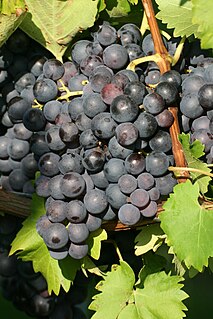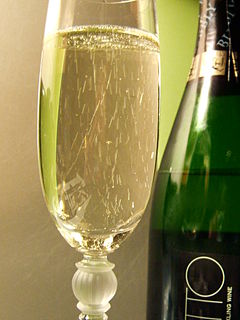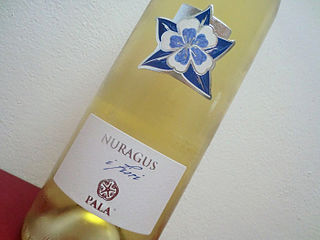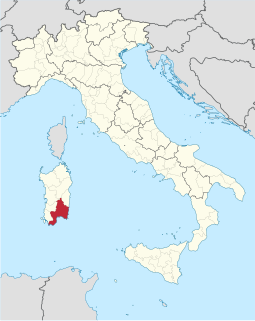
Carignan is a red grape variety of Spanish origin that is more commonly found in French wine but is widely planted throughout the western Mediterranean and around the globe. Along with Aramon, it was considered one of the main grapes responsible for France's wine lake and was a substantial producer in jug wine production in California's Central Valley but in recent years, it has been reborn as a flagship wine for many cellars in the south of France as well as in Catalonia.

The Piave is a river in northern Italy. It begins in the Alps and flows southeast for 220 kilometres (140 mi) into the Adriatic Sea near the city of Venice. One of its tributaries is the Boite.

Trollinger, Schiava, or Vernatsch, is a red German/Italian wine grape variety that was likely first originally cultivated in the wine regions of South Tyrol and Trentino, but today is almost exclusively cultivated on steep, sunny locations in the Württemberg wine region of Baden-Württemberg. It is primarily known under the synonyms Trollinger in Germany, Vernatsch in South Tyrol and Schiava in other Italian regions. As a table grape the variety is sometimes known as Black Hamburg, which is commonly confused with the similar synonym for Black Muscat—a variety that is actually a cross of Trollinger and Muscat of Alexandria.

Castel San Lorenzo is a town and comune in the province of Salerno in the Campania region of south-western Italy.
Vernaccia di Oristano is a white Italian wine grape variety grown on the island of Sardinia which makes a wide range of wine styles for the Denominazione di origine controllata (DOC) of Vernaccia di Oristano based in the province of Oristano. This includes both dry and sweet wines as well as fortified "sherry-like" wines aged in a solera. The grape has a long history on the island of Sardinia with Sardinians claiming that consuming ample quantities of wine produced from the grape as being responsible for low instances of malaria on the island.
Greco is an Italian wine grape that may be of Greek origin. The name relates to both white (Greco bianco) and black (Greco nero) grape varieties. While there is more land area dedicated to Greco nero, the Greco bianco is the grape most commonly referred to by "Greco". In the Campania region it is used to produce the Denominazione di Origine Controllata e Garantita (DOCG) wine Greco di Tufo. In Calabria, it is used to make the Denominazione di Origine Controllata (DOC) wine Greco di Bianco. The name "Greco" is sometimes used as a synonym for several varieties of supposed Greek origins-most notably Trebbiano.
Perricone is a red Italian wine grape variety that is grown in Sicily. In the late 20th century there was around 1000 hectares/2,500 acres of the grape planted throughout the island. According to wine expert Oz Clarke in Sicily Perricone is used to make full bodied, deeply colored, highly alcoholic wines.
Abrusco is a red Italian wine grape variety grown primarily in the Tuscany region where it is a minor blending component permitted in the wines of Chianti. The grape has long history in the region and was mentioned in 1600, under its synonyms Abrostino and Colore, in the posthumously published work by Italian agronomist Giovan Vettorio Soderini Trattato della coltivazione delle viti, e del frutto che se ne può cavare. There Soderini notes that the grape was often used to add deeper, more red color to Tuscan wines.
Pomino is a village belongs to the municipality of Rufina, in the province of Florence, region Tuscany. The village of Pomino is 7,36 kilometers far from the same town of Rufina to whom it belongs. The locality of Pomino rises 585 meters above sea level and the population counts 228 inhabitants.
Girò is a red Italian wine grape variety that is grown on Sardinia and is used mostly in the production of fortified wines in the Giro di Cagliari Denominazione di origine controllata (DOC). The grape was once widely planted throughout Sardinia but its plantings were decimated when the phylloxera epidemic hit the island at the end of the nineteenth century. At the turn of the 21st century there were 552 hectares of the grape planted throughout Italy, mostly in the Sardinian provinces of Cagliari and Oristano.

Vien de Nus is a red Italian wine grape variety that is grown primarily in the Valle d'Aosta DOC. It is particularly associated with the town of Nus where it is the primary grape in the Nus Rosso wine of the region. Outside of this region, the grape is rarely found elsewhere and is nearly extinct.

Verdiso is a white Italian wine grape variety grown primarily in province of Treviso in the Veneto wine region of northeast Italy. It is a permitted variety in the sparkling wine Denominazione di origine controllata DOC of Prosecco located north of the city of Treviso along the Piave river.
Pollera nera is a red Italian wine grape variety that is grown primarily in the Liguria wine region and northwest Tuscany. Ampelographers believe that the vine has a very long winemaking history but it is rarely seen today. It is believed to have been descended from the Chianti wine grape Mammolo and the Corsican wine grape Sciacarello which would make it a half-sibling of Colombana nera.

Colli di Luni is an Italian Denominazione di origine controllata (DOC) located in both Liguria and Tuscany in northwest Italy. The DOC produces both reds and white wines made primarily from Sangiovese and Vermentino with a varietal Vermentino also being produced in the DOC.
Ortrugo is a white Italian wine grape variety that is grown in the Piacenza hills of the Emilia-Romagna region of north central Italy. Here the grape is often blended with Malvasia in the DOC white wines of the area. According to wine expert Oz Clarke, the grape has moderate acidity with high alcohol potential and often contributes a deep yellow color to the wine. In some regions the grape is used in slightly sparkling frizzante and fully sparkling spumante wines.

Nuragus is a white Italian wine grape variety that is grown in Sardinia. It is the principle variety between the Denominazione di origine controllata wine Nuragus di Cagliari. The grape has a long history on the island with ampelographers believing that the variety was likely introduced to the area by the Phoenicians. While the grape is still widely planted in Sardinia its numbers began to dwindle in the late 20th century, falling by 50% during the 1980s alone to a total of 8,700 hectare in 1990. Today it is mostly found in the southern part of the island between Cagliari and Oristano on the hot Campidano plain.
Neyret is a red Italian wine grape variety that is grown in the mountainous Valle d'Aosta wine region of northwest Italy though most plantings are in the slightly less mountainous terrain of southeast Aosta Valley bordering the Piedmont wine region. DNA profiling has confirmed that the variety is a Vitis vinifera crossing of Mayolet and Roussin.

Nasco is a white Italian wine grape variety that is grown primarily in Sardinia around the city of Cagliari. The grape has a long history on the island and is described by wine expert Jancis Robinson as "ancient". There is a special Denominazione di origine controllata (DOC) designation, Nasco di Cagliari, for varietal wines that are 95–100% Nasco.
Abbuoto is a red Italian wine grape variety that is grown primarily in the Lazio region of central Italy. Historically the grape was believed to be responsible for the Ancient Roman wine Caecubum that was praised by writers such as Pliny the Elder and Horace but historians and wine experts such as Jancis Robinson and Julia Harding note that connection is likely erroneous.
Avanà is a red Italian wine grape variety that is grown in the Piedmont wine region of northwest Italy. Historically, the grape has also been grown in the Dauphiné and Savoie wine region of eastern France where it was known as Hibou noir and in the Valais region of Switzerland. The grape is most often used as a blending variety in the Denominazione di origine controllata (DOC) zones of Pinerolese, with Barbera, Persan, Freisa and Neretta Cuneese, and Valsusa, with Barbera, Dolcetto, Neretta Cuneese and other local red Piemontese varieties.









